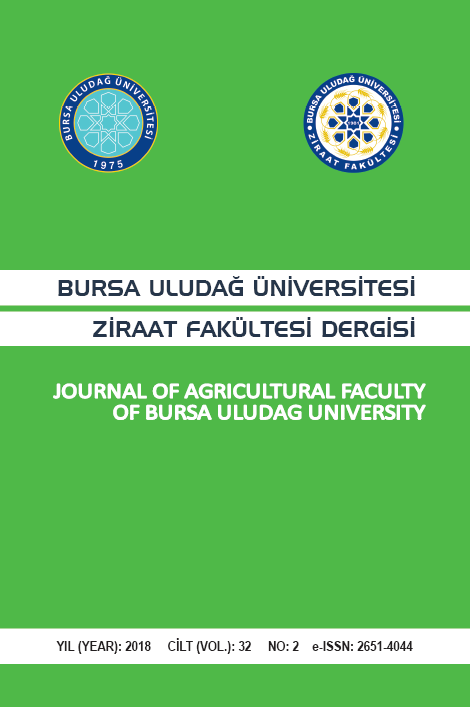Bitkisel Üretimde Allelopati
Allelopati, Ekim Nöbeti, Anızlı Nadas, Sürdürülebilirlik
Bitkisel Üretimde Allelopati
-,
___
- Anonmous 2013a. http://www.google.com.tr/search? (Alıntı Tarihi: 06.03.2013)
- Anonymous 2013b. http://csip.cornell.edu/Projects/CEIRP/AR/Allelopathy.htm (Alıntı Tarihi: 22.08.2013)
- Altieri, M.A., Deborah, K.L. and J.R., Davis, 1983. Developing sustainable agroecosystems. BioScience. 33: 45–49.
- Batish, R.D., Singh, H.P. and S. Kaur, 2001. Crop allelopathy and its role in ecological agriculture. J. Crop Product. 4: 121–161.
- Colquhoun, B.J, 2006. Allelopathy in weeds and crops: Myths and facts, Proc. of the Wisconsin Fertilizer. Aglime & Pest Management Conf. 45: 318–320.
- Çanakçı, S, 2009. Arpa (Hordeum vulgare L. cv.) tohumlarının çimlenmesi, çeşitli büyüme parametreleri ve pigment miktarları üzerine salisilik asit ve ferulik asitin etkileri. Fırat Üniv. Fen Bilim. Dergisi. 22: 37–45.
- Duke, O.S, 2010. Allelopathy: Current status of research and future of the discipline: A commentary. Allelopathy J. 25: 17–30.
- Etherington, J.R, 1975. Allelopathy, In: Environment and Plant Ecology. By. W. Armstrong. John Wiley & Sons, London, New York, Sydney, Toronto, 296, 347 pp.
- Francisco A.M., J.M.G. Molinillo, J.C.G. Galindo, R.M. Varela, A.M. Simonet and D. Castellano, 2001. The use of allelopathic studies in the search for natural herbicides. J. Crop Product. 4: 237–255.
- Gençtan, T, 2013. Tarımsal Ekoloji. Ders Kitabı, 6/3, T.C. Namık Kemal Üniv. Zir. Fak., Tarla Bitkileri Bölümü, s: 354, Tekirdağ.
- Gürsoy, M., A. Balkan ve H. Ulukan, 2012. Ecophysiological responses to stress in plants: A general approach. Pakistan J. Biological Sci. 15(11): 506–516.
- Kebede Z, 1994. Allelopathic chemicals: Their potential uses for weed control in agroecosystems. Dept Plant Pathology and Weed Science, Colorado State University, Fort Collins, CO, USA.
- Kohli, R.K., D. Batish and H.P. Singh, 1997. Allelopathy and its implications in agroecosystems. J. Crop Product. 1: 169–202.
- Könnecke, G, 1976. Münavebe. Türkiye Şeker Fabrikaları A.Ş. Yayın No: 207. VEB Alman Tarım Yayınevi. Berlin. s: 29–31.
- Lam, Y., Wing, S.C., Tong, Y., Ng, T.N., Wai, T.C., Wen, H.C., Xiang, Q., Lin, X. and Y. Zhang, 2012. Research on the allelopathic potential of wheat. Agric. Sci., 3: 979–985.
- Mamolos, P.A. and K.L. Kalburtji, 2001. Significance of allelopathy in crop rotation. J. Crop Product. 4: 197–218.
- Macias, A.F., Molinillo, J.M.G., Varela, R.M.and J.C.G. Galindo, 2007. Allelopathy – A natural alternative for weed control. Pest Manag. Sci. 63: 327–348.
- Manuel, J.R., A. Sánchez–Moreiras and L. González, 1999. Ecophysiological approach in allelopathy. Critical Reviews in Plant Sci. 18: 577–608.
- Narwal, S.S., Palaniraj, R. and S.C. Sati, 2005. Role of allelopathy in crop product. Herbologia. 6: 1– 73.
- Oueslati, O., 2003. Allelopathy in two durum wheat (Triticum durum L.) varieties. Agriculture, Ecosystems and Environ. 96: 161–163.
- Perez, F.J, 1990. Allelopathic effect of hydroxamic acids from cereals on Avena sativa and A. fatua. Phytochemistry. 29 (3): 773–776.
- Reigosa, M.J., Pedrol, N., Sanchez–Moreiras, A.M. and L. Gonzales, 2002. Stress and allelopathy. In: Allelopathy, from Molecules to Ecosystems. M.J. Reigosa and N. Pedrol. (Eds.). Science Publishers, Enfield, New Hampshire.
- Rick, W.J, 2007. The history of allelopathy. Springer: 3, ISBN 1–4020–4092–X, Retrieved 2009–08– 12.
- Singh, H.P., B.R. Daizy and R.K. Kohli, 2001. Allelopathy in agroecosystems. J. Crop Product. 4: 1– 41.
- Ulukan, H, 2008. Agronomic adaptation of some field crops: A general approach. J. Agronomy & Crop Sci. 194: 169–179.
- Yılar, M., 2007. Polygonum cognatum Meissn. (Madımak)’un allelopatik potansiyelinin belirlenmesi, T.C. Gazi Osman Paşa Üniv. Zir. Fak., Bitki Koruma Bölümü, (Basılmamış) Yüksek Lisans Tezi, s: 73, Tokat.
- Zuo, S., Ma, Y., Deng, X., and L. Xiuwei, 2005. Allelopathy in wheat genotypes during germination and seedling stages. Allelopathy J. 15: 21–30.
- Yayın Aralığı: Yılda 2 Sayı
- Başlangıç: 1982
- Yayıncı: Bursa Uludağ Üniversitesi
Dünyada Üretilen Fermente Ürünler: Tarihsel Süreç ve Sağlık ile İlişkileri
Merve Şeyda KARAÇİL, Nilüfer ACAR TEK
Önder CANBOLAT, Hüseyin KARA, İsmail FİLYA
Türkiye'de Tavuk Eti Tüketim Alışkanlıkları ve Marka Tercihleri
Sertaç DOKUZLU, Oktay BARIŞ, Canan HECER, Metin GÜLDAŞ
Süt Ürünlerinde Probiyotik Bakterilerin Mikroenkapsülasyonu I: Enkapsülasyon Teknikleri
Farklı Demir Dozlarının Limonium sinuatum Bitkisinde Gelişim, Verim ve Kalite Üzerine Etkisi
Hülya AKAT, Hakan ALTUNLU, Bihter ÇOLAK ESETLİLİ, Özlem AKAT, Gülbin ÇETİNKALE DEMİRKAN, İbrahim YOKAŞ
